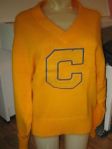 More than once I have heard teachers say something like “she’s a C student.” Having taught in NY, OK, CA and now GA, I have heard such comments in each school. Although I have tried, I never have understood precisely what my colleagues mean. Traditionally, students take a variety of courses. Couple this tradition with the knowledge that we all have affinities for certain subjects: she loves Biology, and he always look forward to History class. Is she a “C student” just in Art or Math, but not in Biology? How about him? More importantly, once a teacher imbibes the thought that “she is a C student,” how does that belief affect the “C student”?
More than once I have heard teachers say something like “she’s a C student.” Having taught in NY, OK, CA and now GA, I have heard such comments in each school. Although I have tried, I never have understood precisely what my colleagues mean. Traditionally, students take a variety of courses. Couple this tradition with the knowledge that we all have affinities for certain subjects: she loves Biology, and he always look forward to History class. Is she a “C student” just in Art or Math, but not in Biology? How about him? More importantly, once a teacher imbibes the thought that “she is a C student,” how does that belief affect the “C student”?In the paragraph below, a high school senior addresses the power of naming. Through this brief writing about Mary Shelley’s Frankenstein, she argues that when someone consistently receives a judgment about herself, she starts believing that label. Student readers, when thoughtfully engaged, have plenty to teach us about how to teach them. We have to keep our minds and hearts open to such possibilities. (n.b. I have left this writing as is–without editing, except in one case of bracketed letters. The student wrote this during class as an email, in response to a particular question about the story’s driving forces.)
______________________________
Based on my reading of Volume 2, I believe that the most paramount concern that governs the direction of the novel is the questionable judgements by which physical differences are termed monstrous. Many times, society unjustly characterizes people’s qualities as “evil.” The monster in the novel “Frankenstein” was not necessarily created bad, but over time, after society socially exiled and evaded him, he turned into what they deemed him to be. One can only stay good for so long when everybody else is telling him that he is bad. “They are kind–they are
the most excellent creatures in the world; but, unfortunately, they are prejudiced against me. I have good dispositions; my life has been hitherto harmless, and, in some degree, beneficial; but a fatal prejudice clouds their eyes, and where they ou[gh]t to see a feeling and kind friend, they behold only a detestable monster” (102). Society’s preconceived notions of good and evil turn innocent people into monsters because they do not give them a fair chance to prove their innocence. If people are called something for so long, they will eventually turn into
that very thing. For example, the monster eventually turned evil and “the mildness of my nature had fled, and all within me was turned to gall and bitterness” (107). The monster could not control himself anymore after being repeatedly shunned and ridiculed by society. He gave up trying to be a noble and good person because no matter what he did, society always found a way to exclude and punish him. Society unfairly judged his differences as evil just because he did not look, speak, and act like everybody else did. As the monster became more and more excluded from society, he developed more and more negative qualities. This made people think that he was evil all along when in actuality, it was just their harsh judgements that turned him against mankind. The monster said “All men hate the wretched; how then must I be hated, who am miserable beyond all living things!”(72). After being told so many times that he was “the wretched” because of his differences, such as his appearance, he began to believe it himself and accepted the hatred. Overall, it is societies prejudice towards those who are different than the norm that turn the monster evil and shape the majority of the direction of the novel.
photo credit: http://thumbs1.ebaystatic.com/d/l225/m/mBiAbwoDO_MevlOekwpd1dw.jpg

Thank you for this, Bill. I am sharing it with my 9th graders. Today, they discussed Sandara Cisnero’s short story “Eleven.” The protagonist, Rachel, is forced by her teacher Mrs. Price to take ownership for an abandoned red sweater left in the classroom. Unable to resist Mrs. Price’s authority, Rachel sinks under the weight of being unheard and of her teacher’s assumption that the raggedy, old sweater must belong to her. When she’s finally forced to put the sweater on, she dissolves in tears. Worse, Rachel says, “I put my head down on the desk and bury my face in my stupid clown-sweater arms.” The sweater is now hers; she has internalized its ownership.
We teachers need to be wary of the lessons we’re teaching.
Indeed. I’m struck by the power of the physical symbol in the Cisneros story; I did not know this story and am glad to learn about it.
Stay tuned for a piece of high-school-sophomore paragraph on a similar subject.